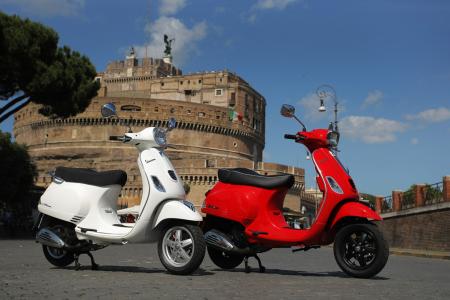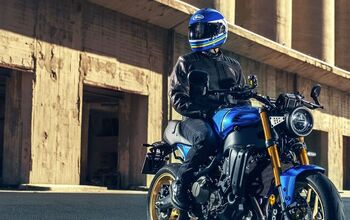2013 Vespa LX and S 125/150 3V Review - Motorcycle.com
The iconic Vespa brand known the world over gets a new engine to power two of its most popular scooters, the S and the LX. A 125cc version will be sold in most world markets, but North America will receive only the 150cc models. They’re not expected to arrive on our shores until late this year or early next as 2013 editions, possibly even 2014s. MSRPs haven’t yet been set, but we expect only a modest bump in price from the current models: $4499 for the S; $4599 for the LX. -Ed.
Born out of a strong necessity for cheap transportation in 1946, Vespa has sold some 17 million vehicles over its 66-year history. We got to test the latest versions of the S and LX models with new 3-valve engines in Rome; the home of Vespa.
I chose one of the LX 150’s as my first ride and was immediately struck by just how small it is. Both the LX and the S are tiny and this makes them exceedingly responsive. These small-chassis scooters weigh in at just over 240 pounds, so my 200 pounds are definitely the boss and not the little Vespa.
The LX’s brown leather seat is very comfortable with space for two. The S also has a comfortable seat with a stylish white leather seam surrounding it. From the rider’s seat, the two new models look different, as the LX has a newly designed digital instrument console whilst the S makes do with two old-fashioned analog clocks with instruments lined under.
The LX 125/150 3V also features a large lockable glove compartment whilst the S 125/150 3V makes do with two open pockets. Both have a carrier hook for a bag of shopping. Under the seat there’s room for a small helmet and a couple of things, such as an extra jacket should the weather change.
The LX 125/150 3V Touring have chrome luggage racks front and back that’ll allow for a large bag being strapped to the back and a sleeping bag or similar at the front. With the Touring additions the LX changes its appearance to something like a custom scooter, so style has been taken care of even if you’re of a more practical inclination. I’d highly recommend the 150 version for Touring, as a couple of extra horses and a little more momentum will be welcome with the extra weight expected.
The real news of the LX and S 125/150 3V is of course their new 3-valve air-cooled four stroke engines. Hidden under the steel-bodied Vespa we find a 124cc or a 155cc engine of 11.6 and 12.9 horsepower, respectively. It may not seem much of a difference, but riding the two back to back I much preferred the 155cc powered version as it has more torque earlier on in the rev range and therefore responds much quicker when it’s time to leave other traffic behind us around Rome. North American riders won’t have the choice of the 125cc models.
I was truly impressed by the small and intricate new machine developed at Piaggio’s Pontedera plant in Tuscany. On my second tour of Rome of the day we pushed the S 150 3V to its absolute top speed, and the instruments showed 110 kph (68 mph). The main difference you can feel between the 125 and the 150 is the initial drive.
The stability both at speed and over uneven road surfaces is impressive for such a tiny vehicle. The front wheel is an 11-incher and the rear a 10-inch, and on them sit Michelin Pilot City tires which are good for all-round use with enough grooves for a rainy ride. The front tire is a 110/70 and the rear a 120/70. The front suspension is a coil spring and dual action monoshock on a single-sided arm and a preload-adjustable monoshock at the back. The S model has red coils and the LX black coils.
I found the suspension to work remarkably well and it was full throttle over anything from cobbled streets, small potholes and uneven surfaces. The reinforced steel body along with the engine and the front swingarm acts as the chassis. There’s nothing plastic about a Vespa, and this can be felt when you ride over the many uneven surfaces where a “plastic” scooter would make noises that would make you believe it was about to shake itself into bits.
When in Rome do as the Romans, and that’s exactly what I did, keeping my mobile phone in the left front compartment on the S 125 or 150 and checking my messages and taking photos which went straight up to Facebook whilst still in the saddle. I can’t recommend this to anyone, of course, as it’s illegal in most countries and probably also in Rome, so stick to a Bluetooth headset instead.
I chose the S150 for carrying a passenger, and it was no problem at all. Even with a pillion there is good initial drive and both travel in comfort.
The S 125/150 is easily distinguished from the LX in that it has a square headlight and chromed mirrors whilst the LX has round items. The LX is also slightly more sophisticated with more chromed parts. Both models have an 8.3-liter (2.2 gal.) fuel tank, and Vespa claims that fuel consumption is of 55km per liter (129 mpg) if riding at a constant speed of 50 kph (31 mph). The new service intervals are set at 10,000 kilometers (6,213 miles).
Conclusion
In 2011 Vespa sold 115,000 of these little wonders, and that alone tells us that people love the Vespa brand and the vehicles. They are cheap and practical to run, you don’t have to know anything about motorcycles, and even though pricey, they tend to hold their value very well.
These two Vespas are obviously aimed at smaller riders, but even my Size Large body felt comfortable riding them. I prefer the 150 versions for obvious reasons, but if you even smell a whiff of hassle upgrading from a 125 license than it’s not worth it. Being so small and light they are easy even for those without much arm strength to get up on the centerstand. Finally the Vespa LX and S 3V models are easygoing, stylish, light and practical inner city scooters, and for that purpose they are perfect.
Related Reading
2008 Vespa S 150 Review
2008 Vespa LX 150 Review
2012 Yamaha Zuma 125 Review
2012 Piaggio Typhoon 125 Review
More by Tor Sagen

































Comments
Join the conversation